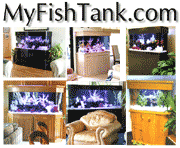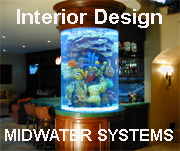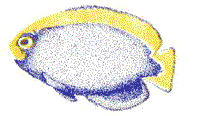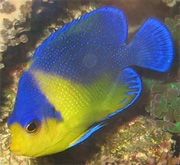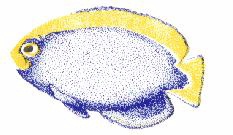|
Lighting the Reef Aquarium
By Dana Riddle
Riddle Aquatic Laboratories
Lighting is one of the most important aspects of successful reef aquaria
and one of the most confusing for many hobbyists. Magazine
ads often boast that a particular lighting system is "best", leading to
further confusion. The truth is that there is no universal "best"
lamp. One
should make decisions based on what they wish to achieve. This
short article will examine various options available to the beginning hobbyist
and aid in choosing an appropriate set-up for his or her needs.
While I don’t think there are any true experts in the lighting field, I’ll
convey my personal observations made while examining different lights.
This research has been conducted over the last 6 years, during which I
have made over 60,000 light measurements under lamps ranging from 9 watt
Power Compacts to 1,000-watt Sulfur lamps. I also managed a
commercial coral farm for two years and made observations and measurements
of literally hundreds of marine invertebrate species. With
this introduction out of the way, let’s get started.
We’ll begin with the most important part of any reef aquarium - you.
What Is Your Goal?
First and foremost, the hobbyist should have an idea as to what the
aquarium should be. Many hobbyists may want a reef tank with
just one or two corals and many fishes. Remember, the coral
doesn’t "know" if it is the only coral in the tank! This doesn’t
alter the amount of light that it may require! If a "minimal" reef
aquarium is your goal, perhaps
selecting invertebrates with low light requirements is your best bet
(we’ll discuss this later.) If you have some aquarium experience,
perhaps you’ll want to set up a small propagation tank, one in which you
can experience the satisfaction of "pruning" and growing your corals, thereby
reducing collection pressures on natural reefs. Or maybe your
goal is the ultimate challenge - that of a densely-packed small polyp stony
(SPS) corals from a reef crest; one where you wish to promote and maintain
the wonderful array of fluorescent colors.
Within the scope of this article, all these tanks have one thing in
common - proper lighting. We’ll now examine why many corals
need "good" lighting.
Corals and Zooxanthellae
Many corals (which are animals) contain algae within their tissues.
More correctly, these algae are dinoflagellates, collectively called zooxanthellae.
It is the zooxanthellae that require proper light. There are many corals
that do not contain zooxanthellae, such as "Sun Corals" (Tubastrea species),
"Carnation Corals" (Dendronephthya species) and others. Generally, these
corals are difficult to keep and it is best to first get experience with
corals containing zooxanthellae.
Zooxanthellae live within the coral tissues in a symbiosis - a relationship
in which both the host (the coral) and the symbiont (the zooxanthella)
mutually benefit. The zooxanthellae live in a protected environment
and use the coral wastes (such as carbon dioxide and forms of nitrogen)
as a food source. From these wastes, zooxanthellae produce
food for the coral
(in the form of amino acids, fatty acids, etc.)
Millions (if not billions) of zooxanthellae can live in the tissues
of a single coral colony. In fact, the brown coloration of
many corals is due to the zooxanthellae. If the coral becomes
stressed (too much light, water too hot or cold, too much ultraviolet radiation,
etc.), it will often expel zooxanthellae. The coral then is
said to be "bleached" and will probably die.
It is very important to keep the zooxanthellae alive and well - the
coral must be treated as more of a plant than an animal. And one of the
most important aspects is proper lighting. Zooxanthellae contain
pigments that "harvest" light and use it for the process of photosynthesis.
For this article, we’ll consider two of the most important pigments - Chlorophyl's
"A" and "C." Generally, these two pigments collect blue and red light in
order to promote the photosynthetic process (this is the reason that
"plant lights" appear a rather purple color - it is a combination of red
and blue light.)
Most aquarium lights make blue and red light - therefore, almost any
lamps marketed for aquarium use are suitable. The question
therefore becomes one of intensity - just how much light is actually needed
for a successful reef tank. We’ll get into a little detail on intensity
of certain wavelengths for those wishing to maintain coral coloration later
in this article.
Why Is Intensity Important?
I’ll try to keep the technical jargon down, but we should discuss a
few important aspects of phycology (the study of plants).
Zooxanthellae, like many plants, can adjust to varying degrees of light
intensities. There are many terrestrial plants that prefer
shade, while others prefer full sunlight. Zooxanthellae in coral tissues
appear to have preferences as well. A quick explanation may put things
in perspective.
Zooxanthellae have a minimal light requirement called the Compensation
Point. This is the point at which the oxygen produced by photosynthesis
is equal to the oxygen requirement of the zooxanthellae. If light intensity
is too low, a zooxanthella will not produce enough
oxygen to meet its respiratory requirements and probably will not use
enough of the coral’s waste products to be of any use. So, an increased
photo period (the amount of time that the lamps are on) will not make up
for an insufficient amount of light. Bottom line: The amount
of light must exceed the Compensation Point!
Zooxanthellae also have a maximum light level - this is called Saturation
Point. Exceeding the Saturation Point is senseless, as increasing
the amount of light will not enhance the rate of photosynthesis.
Just one last term - Photoinhibiton. Photoinhibiton is when
there is so much light that the photosynthetic process begins to shut down.
In essence, too much light is just as bad as too little, resulting in the
same effects. There is some debate as to whether this actually happens
in
aquaria. My personal opinion is that it happens a great
deal. Two examples: Try to get some of the pretty red calcareous
algae (Peyssonnelia, for instance) to grow directly under a 400 watt metal
halide lamp. Try the same with some of the "Mushroom Corals"
(Discosoma species). The calcareous algae will die within a
few days’ time; the Mushroom Coral will
react in a negative fashion and will shrivel in an attempt to hide
from the light and will often die.
The question invariably arises - how much light is "too little" and
how much is "too much?" Unfortunately, there is not a pat answer
for this question. However, based on thousands of observations
and a lot of tedious lab research, I will stick my neck out and make a
"middle-of-the-road" recommendation as to a good compromise for those
wishing to maintain soft corals and some of the low light stony corals.
So, here it is: There should be a minimum light intensity of 3,000-lux
reaching the deepest point in the aquarium. What the heck is
a "lux?" Lux is a photometric measurement of light intensity; maximum sunlight
lux values (noon on a clear day in the tropics) are generally considered
to be 100,000 - 120,000 lux. This is a recommendation of just
barely 3% of
maximum surface lux values! Although it doesn’t seem like
a lot of light, it will take some doing to get this amount into an aquarium
in a darkened room.
Based on this recommendation, we can begin looking at what sort of lighting
we should use (based on an aquarium 48" long and no deeper than 18"-20".)
Recommended Lamps
Regular Output Fluorescent Lamps - For the hobbyist on a budget,
regular fluorescent lamps are hard to beat. The standard size is
a lamp 1.5 inches in diameter, 48" inches long and
rated at 40 watts. Use 6 of these (4 "daylight" lamps and
two of the ones producing blue light (called Actinic lamps) in a polished
aluminum reflector(s) and have them no more than 4 inches above the water’s
surface. Preferably, replace 2 of the lamps every three months or all 6
at six-month intervals. If your aquarium is not wide enough
to accommodate 6 lamps, you’ll have to upgrade to Very High Output (VHO)
Fluorescent lamps. (There are High Output (HO) lamps available, but these
seem to have inexplicably fallen out of favor.)
VHO (Very High Output) Fluorescent Lamps - First of all, Very
High Output lamps require a special VHO ballast. This, in addition, to
the slightly higher cost of the VHO lamps themselves, will not be as easy
on the pocket book. Four VHO lamps (3 "Daylights" and 1
blue "Actinic", or a 50/50 split, should work well ). As with Regular
Output Lamps, change them every 6 months (regardless of what you’re told
in advertisements ).
Power Compacts Fluorescent Lamps - These are fairly recent additions
to the aquarium market. They are "U-shaped" fluorescent lamps and make
slightly more light than VHO lamps. Four 55-watt lamps (2 "daylights" and
2 "Actinics" with an aluminum reflector) will produce more than enough
light if the lamps are 3 or 4 inches above the water’s surface. Surprisingly,
2-96 watt lamps (1 "Daylight" and 1 "Actinic") are just on the borderline
of making the amount
of light we’ve prescribed, so go with 4-55 watt lamps or 3-96 watt
lamps. Light-loss varies among lamps depending upon the manufacturer (Osram,
Philips); changing lamps every six months or so is a good general recommendation.
Lamps to Avoid
Standard Incandescent Lamps -
These are lamps normally used to make basic light in a room.
The spectral output is yellow-orange; in addition these tend to burn rather
hot. There are some incandescent lamps on the market that would
probably promote photosynthesis in zooxanthellae (such as G.E.’s "Sho-and-Gro",
however, these really don’t make enough light and that produced is focused
into a small area since these are normally spot lights. Keep these over
terrestrial plants, not your reef tank.
High Pressure and Low Pressure Sodium Lamps
- These require a special ballast and produce a very yellow
light.
Standard Mercury Vapor Lamps - These
lamps normally make a great deal of light - and ultraviolet radiation as
well.
There are some "special" mercury vapor lamps on the aquarium market
that we’ve tested over fresh-water plant tanks with good success.
They reportedly work well over reef aquaria. These burn hot
(as any High Intensity Discharge lamp will) and make a high amount of UV
energy. The advantage here is cost - a self-ballasted mercury vapor lamp
and fixture can be purchased for less than $50. However, use
an UV shield (such as Lexan Solar - available at Home Depot, Builders’
Square and others) and use a fan to cool the lamp. I would recommend
that a hobbyist attempting to use one of these lamps should have some experience
with reef aquaria.
Quartz Lamps - These are normally
used for outside area lighting. The appearance of objects under
these lamps tends to be a little yellow in color. They also
produce a lot of heat. I’ve heard some reports of a "seaweed"
(Caulerpa prolifera) growing well under one of these lamps - with my tongue
only half-in-cheek, I’ll state that C. prolifera would probably
grow under a flashlight!
Coral Farming
Coral farming presents some special considerations. The
goal is usually to produce salable colonies in the quickest manner possible,
while keeping costs under control. The key to sales is usually
dependent on the color of the coral (especially SPS colonies).
Based on years of experience, I’ll make two specific recommendations.
We’ve used 175 watt Feit and Philips low Kelvin metal halide lamps (around
3,500 - 4,000 K) with excellent results in standard Coralife fixtures (technically
called luminaires). These are particularly effective over aquaria
with depths not exceeding 12 inches (we used eggcrate supported by PVC
pipe to "elevate" the corals closer to the light ). These lamps
are inexpensive - usually less than $20 each at Home Depot.
Colors of SPS corals are usually apparent under these lamps but some of
the green soft corals (such as Sinularia) appear washed out under these
lights. As a footnote, we were disappointed by the apparent
color of some soft corals under these lamps - and so were our customers,
we couldn’t give these corals away! Only when we displayed
these under daylight/actinic combinations or some of the 10,000 - 20,000
K lamps did the startling green coloration become apparent.
The problem was then growing enough of these!
For deeper tanks (up to 30" deep), we like the 400 watt Iwasaki "Daylight"
6500 K lamps. When mounted in a pendent fixture, light is tightly
focused. We strongly recommend using a plastic splashguard
to weaken the amount of UV radiation produced (and to keep water off the
hot lamps). These lamps are more expensive - $50 to $75 each, but are long-lived.
They’ll maintain acceptable light and spectral output for about 18 months,
maybe longer, depending upon the number of start-ups the lamp experiences.
In both cases, space the lamps about 18" to 2 feet apart to keep light
intensity high.
An Interesting Theory - Intensity of Particular Wavelengths in Promoting
Coral Coloration
Recent research has shown that certain wavelengths are responsible for
promoting the vivid coloration in SPS corals. Recent research
has shown that some fluorescent pigments are stimulating by certain light
wavelengths. Blue light triggered the most production, while UV radiation
at 365 nm, was LEAST responsible. With this information, we
could predict
which metal halide or fluorescent lamps are most efficient in promoting
coloration. While I had hoped to include these analyses in
this article, I’ve realized that a good deal of research will be involved.
I’ll have to report later ......so, stay tuned.
This article is the 'paid' property of Aquarium Design and absolutely
no commercial reproduction is permitted without written permission in advance.
Direct your comments or questions to the author at
RiddleLabs@aol.com
|
